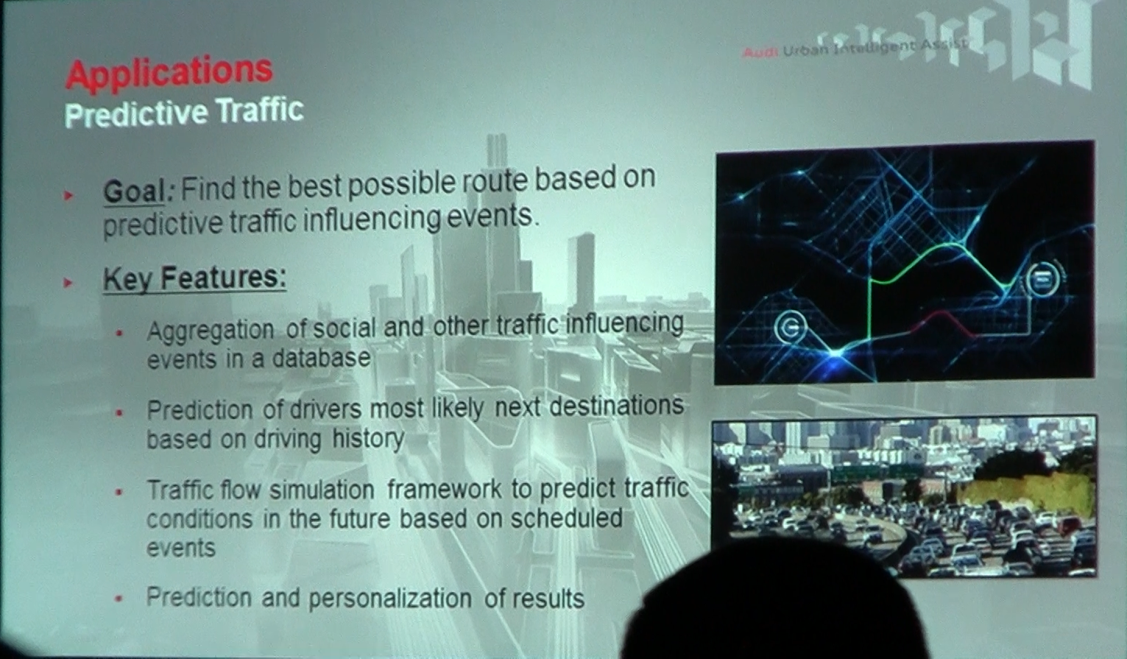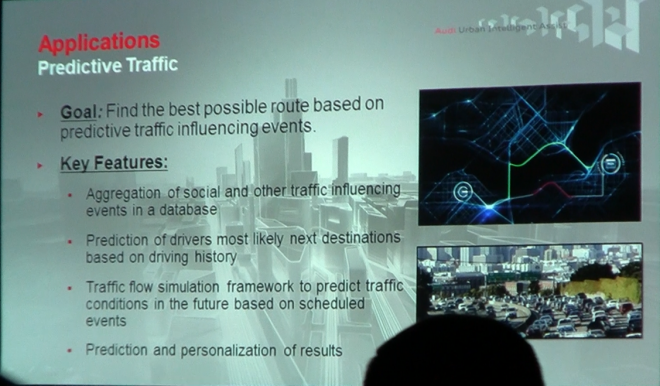The first annual Asia Student Cluster Challenge (ASCC) has raised the bar: a monster LINPACK score and the first-ever three-peat overall champion! Join the conversation at studentclustercomp.com.
Read MoreGTC 2013: Car Crazy: State-of-the-Art Sat Nav and more
Is it easier to drive on a cartoon map or one with real 3D roads, buildings, and sometimes even people? Audi (and Google) believe that more real is more better, so they’ve incorporated Google Earth into Audi’s sat nav. (This feature is also available in some VW models as well.) It’s not a completely new feature, but it’s been upgraded substantially over the past few years to be much more than just nav with satellite photos.
In this short video Dave Anderson, NVIDIA’s Automotive Applications Manager, walks us through the nav feature on an Audi A7 that was parked on the show floor at GTC 2013. In our exercise, we charted a course from the San Jose convention center to downtown Detroit – a 2,400 mile trip.
Read More
GTC 2013: Car 2.0; Software-defined driving
What’s your next car dashboard going to look like? The answer may well be: however you want it to look. If NVIDIA has its way, car manufacturers and owners will have a much wider range of choices when it comes to dashboard displays, navigation sophistication, and personalizing car to owner.
The computer hardware foundation is NVIDIA’s Visual Computing Module (VCM), a small computer on a card with a Tegra processor, RAM, and solid state memory. This module is the brain of the car-to-user interface: it manages the instrument cluster, entertainment system, climate control, communications, and navigation tasks.
If NVIDIA’s VCM catches on, it could give rise to a new wrinkle in the auto market: an upgrade path. In the past, cool new features were introduced to the motoring public in new models every year or two. Sure, you could upgrade the entertainment and nav features with aftermarket products, but installing a fully integrated solution can be an expensive proposition. Many drivers take the cheap route by using their smartphones or other devices for directions or entertainment storage.
According to Dave Anderson, NVIDIA’s Automotive Applications Manager, NVIDIA is planning to keep the same packaging (including the pinout) for successive VCMs, so they’d have socket compatibility from generation to generation. Improvements could include more memory, more processing power, and new features/functions that the faster hardware would enable.
IBM Elective X-ectomy? Partial or Full?
Is IBM selling all or part of their x86 server biz to PC giant Lenovo? Nothing has been confirmed by either party, but it sure looks like there’s something in the works. So what might this deal look like? Begin speculation mode now…
I don’t see IBM selling off the entire System x division to Lenovo. What they’ll sell is the most commoditized and least differentiated boxes in their product line. This means goodbye to their single- and dual-socket tower servers for sure. It also means that they’ll probably bid farewell to almost all of the models in their M3 and M4 rackmount server lineup. Selling off this part of System x removes sixteen SKUs. So what will IBM keep?
Read MoreRadio Free HPC: The Joy of RDMA?
In this follow-up podcast to the GPU Technology Conference, the RFHPC team mulls over a talk by GE’s Dustin Franklin, GPU app specialist. Dustin’s topic was GPU-direct RDMA; was this a first look at real-world RDMA with GPU-to-GPU communications? Follow…
Read MoreRadio Free HPC: FPGAs and Stuff
In this episode of Radio Free HPC, Rich, Dan, and Henry discuss the recent buzz surrounding FPGAs. After being sidelined by accelerators, they’re increasingly being used in appliances. Big vendors are talking about FPGAs not only for appliances but for…
Read MoreASC13: Shanghai Smackdown
The first annual Asia Student Cluster Challenge (ASCC) culminates this week with a final round of competition that brings ten university teams to Shanghai for a live cluster-off. Learn about the challenge and meet the teams here, and join the conversation at studentclustercomp.com.
Read MoreGTC 2013: Audi Drives Auto Technology; Steers course for safety/convenience
Do you hate driving in the city? Do you fly into a rage when you can’t find a parking spot after spending hours in heavy traffic on the way to your destination? Do you have trouble deciphering SatNav directions while paying attention to your surroundings? Or do you get easily distracted while driving and become a safety threat to all around you? Does the fact that your car can’t predict the future piss you off?
Audi, along with US-based research universities, has been studying just such problems. They provided a peek at their findings and solutions at the recently concluded GTC 2013 show in San Jose. The first finding is that more than 80% of the US population lives in some sort of urbanized area – a 12% increase over the last decade or so. City driving has become more difficult, and most accidents happen in cities – although, in the US at least, rural accidents account for most fatalities.
Audi also found that driver frustration and distraction play a large role in both urban and rural accidents. (I think they’d classify the “driving with their head up your ass” driver as “distracted.”) They did deep research into this topic, breaking accident statistics down into twelve categories such as “forward into decelerating object,” “road depart right/left,” “sideswipe left/right,” etc. These findings and others shaped their solution: “Audi Urban Intelligent Assist.”
The guys from Ingolstadt (Audi HQ) did a good job of laying out their vision for future Audi drivers. It starts, modestly enough, by giving Audi vehicles the ability to predict the future. They’ll also be personalizing cars for individual drivers, improving controls, and providing systems that give more and better automated assistance. These are great goals, but what do they really mean when the rubber meets the road?

Read More
GTC 2013: 63 TFLOP/s in 3U? Like a clown car full of GPUs
If you need lots of compute power, you’re either already using GPU accelerators or taking a close look at them. And if you’re serious about tapping into the full processing power of the GPU, you need to take a look at the newest PCIe switch offering from One Stop Systems.
Dubbed the ioMillennia, it’s a 3U, PCIe Gen3 switch that can handle sixteen full-size GPU cards. We glimpsed this behemoth when walking the floor at GTC 2013 and were attracted like moths to the 42.3 billion candle-power Luxor Sky Beam. (Or, more accurately, like me to a donut display case.)
One Stop Systems VP of Sales Jim Ison walked us through the box, discussing both technical specs and customer usage. It’s quite an achievement, packing 16 hot and power-hungry GPUs into a cramped 3U space. And it does take a little bit of power to run 16 high-performance GPUs – about 6,000 watts provided by three 3,000-watt hot-swappable power supplies. (One is a redundant backup.)
Read More
GTC 2013: Data Center in a Bright Box
One of the best things about industry events like GTC 2013 is walking the trade show floor. It gives me a chance to talk to smaller, niche companies who don’t get the media coverage given to the Industry Titans. (Or to Titan the supercomputer, for that matter.) One floor foray brought me to CreativeC, an HPC consulting and hardware company based in New Mexico. (Here’s a short video of my visit.)
The first thing that caught my eye was their high resolution video wall. With six 46-inch monitors, it was satisfyingly large; and with a full 1080p stereoscopic image, it had breathtaking clarity and image fidelity – at least to my untrained eye. Though the display sported six screens, the system can support up to 16.
Read More

